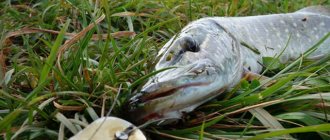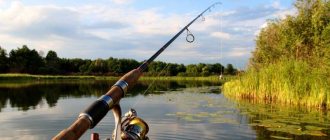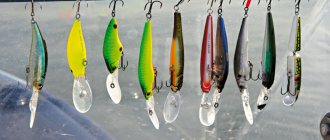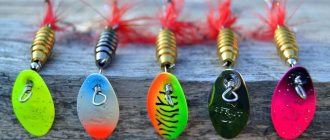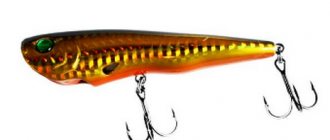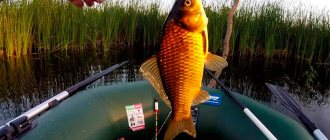The right lures for pike in a spinning rod and working with them on a pond are the key to successful fishing. It’s not easy to understand the conditions of modern marketing - the counters are filled with multi-colored decoys, and each one shouts that it catches better. In this article we will look at which bait is better to catch pike from the point of view of an ordinary fisherman, and not from the point of view of a wise spinning athlete.
Pike fishing with spinning rod
Let’s talk right away - there is no better and working bait. It’s not worth going to the store in search of a philosophical imba that you threw and caught. This is the wrong way. There are many types of spinning baits for pike. Each of them contains features, requirements for gear and fishing conditions. The choice of bait is based on the tactics and characteristics of fishing, personal preferences in the method - jig, twitching, trolling, or a little bit of both. On an overgrown pond, the tactics are one, and on a deep reservoir, another.
They say that pike are indiscriminate - this is far from true. The toothy one grabs everything that moves. However, such periods are rare. The rest of the time, when fishing for pike with a spinning rod, an angler needs to use maximum ingenuity to lure out the predator and provoke an attack.
You need to treat this as a system, which includes the conditions of the reservoir, time, the spinning rod itself with equipment, and pike baits. The result of the correct combination of these factors is the capture of pike. Both old spoons and atoms work, as well as wobblers with jigs - each is better or worse in certain conditions. And which ones specifically – we’ll look at them further.
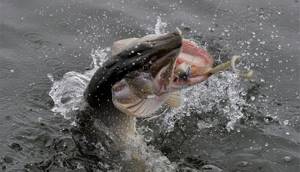
Video: Fishing for pike in summer using a spinning rod from the shore
To consolidate the knowledge gained, let's watch this video. The author catches pike from the shore on an unfamiliar river and gives practical advice on the technique and tactics of searching for “toothy”.
He also tells you what equipment can be useful when fishing. By the way, take this point seriously. Don't neglect the yawner and wire cutters, sometimes they can save you a lot of time. And for the pike itself, this method of removing the hook will be safer if you want to release it back.
Equipment Features
Previously, it was simpler on a spinning rod with a Neva reel - a 0.5-0.6 mm fishing line, a metal leash and a spinner. Now the gear has become light, comfortable and profiled. A soft leash is not suitable for wobblers - you need a twist. And to search for the only pike in a pressed-in reservoir during the period of passivity of the predator, it is better to use transparent fluorocarbon. The choice of bait, of course, is considered together with the equipment and the direction of the spinning rod chosen for fishing.
Fasteners, fastening methods, knotless hooks in a variety of lures allow you to create your own rigs. A catchable bait for pike will not be effective if used incorrectly. As they say, it is the angler who catches the fish, not the equipment. A properly configured spinning rod with the right bait is a tool for this.
Read more about the correct equipment of a spinning rod for pike
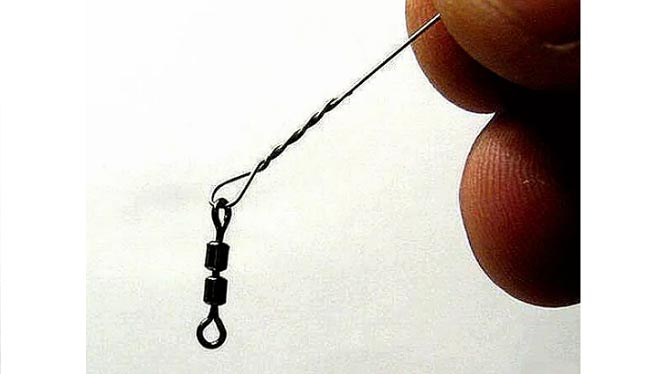
Catching pike on a rig with a dead fish
Today there are various designs of rigs. Experienced fishermen have recently increasingly given preference to rigs with dead fish. It turns out that catching pike with dead fish without a sinker is quite possible.
After all, pike prefer more edible baits, and dead fish can improve the fish’s bite. With the help of such a tackle you can increase the availability of pike.
With such bait you can successfully catch fish in peat quarries. If you want to preserve such bait for a long time, then it is advisable to freeze the fish, since catching pike with dead fish is the most effective method.
How to assemble a set of pike baits for yourself
Each angler has his own best lures for catching pike with a spinning rod. With experience, some are cut off, others take the main place in the box. The wobblers have boxes with bitten fish, the spinners have a set of iron that has been working for years. Still others rely more on homemade pike lures made with their own hands.
- The pool of working baits is large when it comes to specific names and manufacturers. In some hands they catch, in others they don’t. Therefore, we will not compile ratings of pike lures, since it is impossible to do this objectively. Let's look at common and proven types of fishing.
- If an angler is a supporter of a particular type of fishing and bait, then you need to move in this direction. If a spinning player has mastered the use of spinning baits, has been fishing with them all his life, comes to the store and suddenly buys the wobbler he likes for twitching, the legendary rudra - most likely he will not catch anything with it. Unless, of course, you have prepared yourself in theory and studied what kind of spinning rod you need to equip for this wobbler and make a game.
- On the other hand, an experienced twitcher will have difficulty luring a toothy fish into a jig in the absence of a zhor, if he has not used it before. You should not fall for the admonitions of sellers about bait that the angler knows nothing about fishing with. The Internet can help - before you try something new, you need to study it.
- Most amateurs are not adherents of a particular spinning method. More often than not, the approach is universal. Most fishermen have one spinning rod for spinners and jigs, as well as surface poppers or Croats in the grass in the summer. Some took wobblers seriously, without giving up the jig and iron - and successfully. With a regular light and medium class rod you can catch pike successfully with many baits, with the exception of twitching large wobblers. This will require special characteristics of the rod - tanginess, fast action, in order to pull them through.
- However, if you want to try wobblers without buying a special spinning rod for them, this is possible. Some pike minnows are not very persistent - for example, Ito Shiner or its copy from Berking. You need to know which wobbler to take for the specific spinning rod you have. Nowadays, simply getting a spinning rod for everything is no longer the lot of athletes with expensive equipment.
More information about universal spinning rod for the amateur:
https://rybafan.ru/spinningist/osnashchenie-i-snasti/universalnyy-spinning
The message of this paragraph is one - you shouldn’t go to the store and buy what you like, or what you read from incomprehensible ratings compiled without relying on equipment and fishing conditions. It’s better to immerse yourself in theory, study, read normal articles, forums and watch videos on YouTube. Make a list of specific baits in your head and look for these on sale. A general picture of baits that can be used to effectively catch pike is further in the article. Specifics by type - spinners, jigs, wobblers - are in special articles on our website.

How weather affects pike activity in summer
Whether it is scientifically proven or not, the predator really loves bad weather, which, to put it mildly, makes it difficult to sunbathe. It may be a cool day, partly cloudy, with light rain and light wind. At least that's what is believed.
It is also worth noting that before a thunderstorm, the pike becomes more active and begins to eat with appetite. This means that the “toothed one” reacts to atmospheric pressure and wakes up when it decreases or becomes stable. However, when you increase it, you get a completely opposite effect - the pike suddenly stops loving your bait, including its natural diet.
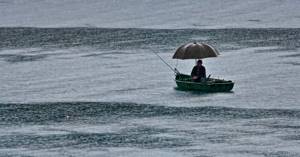
As for the time of release of the predator, it is impossible to say about all reservoirs at once. It’s different everywhere, so it can only be determined most accurately empirically. That is, with your own intelligence or find out from local fishermen who has such data.
However, it is still worth paying attention to the dawn and evening hours, when the sun has already stopped burning. They say that at night you can also count on a catch, but this is rather an exception to the rule.
There is another interesting hypothesis that weather-sensitive people can test from personal experience. Listen to your state before fishing, if you are cheerful and ready for exploits, after a cup of coffee, of course, then perhaps the predator will be active that day. And on the contrary, feeling lethargic, you can’t count on a good bite. Magnetic storms, everything...
All this, of course, is good, but let's better talk about more real things, such as scouting pike places from the shore and from a boat.
Spoons
Old-school spinners rightly believe that the best bait for pike is a large, wide spoon weighing about 20 grams, such as Atom, Storling, Spoon. The new generation of anglers has focused more on jigs and wobblers – also for good reason. We won’t argue – in all these groups of baits there are killer options for pike. I myself have been fishing with spoons for years, but I mastered jigs and wobblers relatively recently.
Detailed article about pike lures and proper wiring:
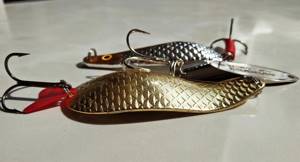
Oscillators
Pike do not take all lures well, and the magazines, meanwhile, are overflowing with iron of various designs. Experience suggests one thing - you shouldn’t fall for the tricks of advertisers and buy expensive hardware for 1000 rubles or more. From the point of view of catching, not collecting. Pike takes ordinary hundred-ruble pieces of iron very well, you just need to choose and use them correctly. There is only one approach - it’s better to have several proven and working baits than a box of untested ones. But these few gain experience. The cool ones go in a box, the non-working ones go on a shelf in the garage.

Pike Killer – Atom 2
The best lures for pike from oscillating spoons are wide, large, with a deep hole in the back. Pike loves uniform amplitude play, waddling from side to side, and gliding oscillations while on vacation. Not all atoms and spoons from the store are equally useful. Some catch, others don't. Therefore, you need to take different manufacturers - Spinex, German, St. Petersburg spinner, etc. Then, after checking, buy in large quantities those that work. An ordinary homemade spoon made from a tablespoon catches better than a commercial spoon, if done correctly.
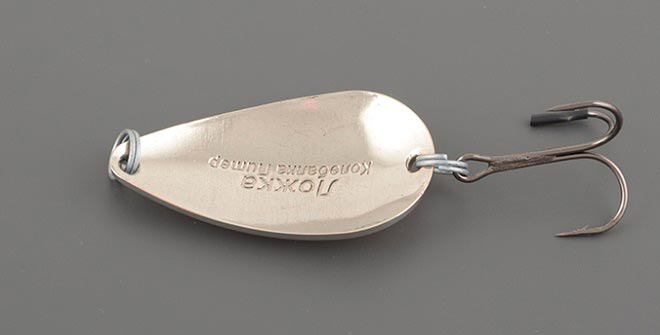
Spoon
Expensive spoons are nickel-plated and galvanized - so the cost grows disproportionately to reasonable limits. Among the cheap iron, you can choose an effective arsenal of spinners for pike. We take ordinary atoms and spoons, senezhes and shtorlings, regular castmasters in three colors - silver, yellow brass and red copper.
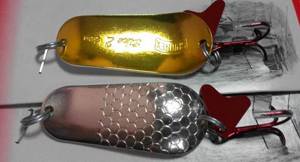
Formotype Storling
If an old, catchy spoon has darkened over time, don’t rush to clean it, it will come in handy in sunny weather. On cloudy days, on the contrary, we use bright glare lures. The weight of the spinners is selected depending on the test of the rod, but usually these are pieces of 10-30 grams.

Purchased lures are being finalized. We replace the winding rings with more reliable ones, enlarge the tee so that it is approximately equal in width to the spoon - otherwise there will be frequent idle grips. We add a provocateur to the tee, which serves as an attack point. Previously, they simply knitted a tassel from red threads, which, if wet, could worsen the performance of the vibrator.
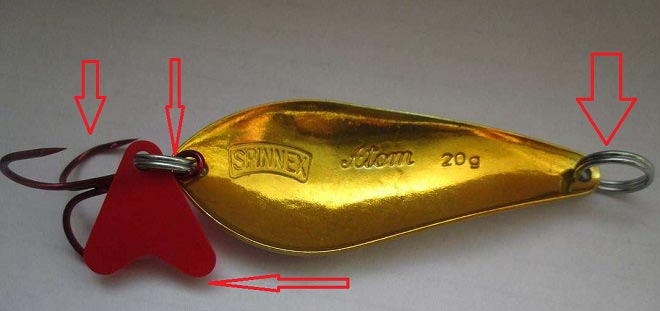
Now it is more practical to use plastic red tails. What you need is red, bright scarlet, and not transparent pink. Pike take better on them, and perch even more so. Red fins can be found in fishing stores. I bought 100 pieces in a bag from Aliexpress at once - it turns out cheaper, and this quantity will last for years.
Red ponytails with Ali, 100 pcs: https://ali.pub/486ize

Turntables
A spinning spoon is also a popular bait for pike, especially in the central regions where there are few large predators. Fishing is mostly for perch, but the toothy one doesn’t miss the spinner either. Naturally, if there is a high probability of pike biting in a reservoir, we put a metal leash, even on a small spinner. In spring, pike are sometimes more willing to take small baits.
Any medium to large sized rotators will do, but usually 03-05. The approach to colors is similar. It’s better to stock up on several models in basic colors, check them, focus on choosing a place and wiring, than to spend 2-3 casts on the whole box of unknown baits. We experiment with colors, sizes and placement of twisters on the hook.

In addition to metallic colors, it is useful to have provocative colors in stock for pike - acidic yellow-green, orange, red. Such bright lures catch an active predator well, especially in muddy water.
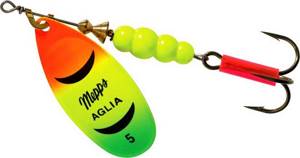
Mepps Aglia №5
The main thing is that the petal starts at low speed. You can drive both branded Mepps Comet, Aglia Long, and Chinese, if the petal rotates normally. The set will require both surface spinners and heavy ones for depth. If there are no deep ones, a sinker is placed in the rig between the spoon and the leader. The attachment on the turntable tee does not affect the rotation of the petal. For pike with spinners, hook baits sometimes work - twisters, tassels, streamers.

Cicadas
Bladebaits, or cicadas, are spinners that vibrate when pulled and are suspended on the back, most often used for perch. However, in some conditions they are useful for luring pike, for example, from behind the edge. To target pike, it is better to use large, heavy cicadas for fishing in deep places.
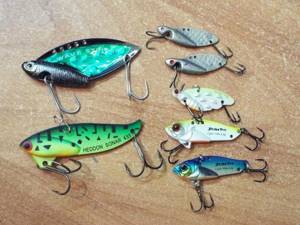
Devons
Devons, or propellers, are to some extent similar to spinners, and are also not originally pike baits. Propellers are more often used for high-speed fishing for asp, perch, chub, which love fast small vibrations, and in small sizes - for semi-predatory fish. However, a hungry toothy beast that goes hunting can grab such a piece of iron.
Cicadas and Devons are not exactly pike baits. Perhaps somewhere in someone's hands they show remarkable results. However, if the angler is targeting pike specifically, it is better to focus on the large spoons and spinners described above, rather than wasting time and effort on the whole variety of spinners. During the feeding period, pike can take anything, but the rest of the time, special toothy baits work better.

Jig
Many spinners combine jig fishing with lures. Of course, for jigging for pike perch or pike perch, it is better to use specialized jig rods with a Solid tip - a thin glued fiberglass tip. Sensitivity is important here - the bites of these predators are often pokes and semi-noticeable grabs.
- Pike usually takes it boldly. The majority of pike lovers do not achieve the condition from the rod that the bait touches the bottom and hits the hand, guided by the sag of the fishing line on a stepped retrieve. In most cases, the pike bite is still felt. Therefore, jig is used together with spinners, on the same rods, of which most amateurs have only one.
- The weight of the jig heads is selected depending on the fishing conditions and the test of the rod. On a regular average spinning rod for pike with a test of 10-30 grams, it is quite comfortable to fish with jig baits with heads from 10 grams, but it is better - 14-16, for better sensitivity. On micro jigs, a much smaller caliber is used, and on heavy spinning rods for Heavy jigs on deep rivers with currents - 30, 40 grams or more.
- Typically, spinners and jigs up to 20 grams are used in small and medium-sized rivers, ponds, and small reservoirs. On a large river at depth, along the edges it is easier to use a heavy jig. However, craftsmen at such points confidently operate heavy vibrators.
- In bushes and shallows, unloaded silicone works well for pike with its wiring on top with stops and twitches.
- In jigging for pike, a simple installation on a jig head is usually used, as well as a swivel connection - an offset hook or a double in a collapsible Cheburashka or through a ring into an eared weight. Spaced rigs such as drop-shot, Carolina, Texas can be useful for passive pike.
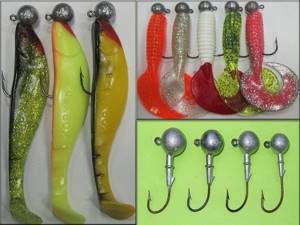
Any silicone or foam fish is placed on the hook. These are vibrotails, twisters, crustaceans, octopuses, worms and slugs. Still, the main artificial bait for pike in a spinning jig is twisters and vibrotails. Pike loves large, bulky baits, especially in the fall. Therefore, in jigs you should not be afraid of size - a 20-centimeter vibrotail can easily attack even small grass. On the other hand, sometimes the toothy one responds better to small baits, down to 1-2 inches, like perch.
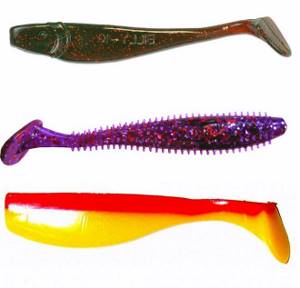
The approach is the same as in wobblers - it is better to use bright, provocative, acidic colors for active pike, and dark, natural colors for passive ones, for example, purple or machine oil.
Retrieving a pike is not always a step at depth. In shallow water and overgrown areas, we use a uniform pattern, hold the bait over the upper edge of the algae, sometimes touching and swiping along it - it works on pike, it’s been tested.
Read more about the right spinning silicone baits for jigging for pike

Fishing tactics
Pike fishing with a spinning rod occurs throughout the entire period of open water. But depending on the time of year, toothfish fishing has its own characteristics. And if in spring and summer predators are caught at approximately the same rate, then during the autumn feeding season you need to choose the right fishing tactics and buy bite activators so that your fishing is successful and troubles pass by.
Let's take a closer look at all the features of the technique and tactics of pike fishing, depending on the time of year and weather, so that every spinning angler can be prepared when going to a pond and have the necessary gear with him.
in spring
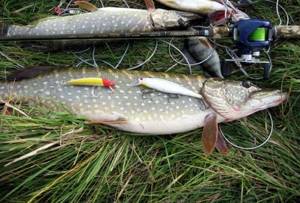
In the spring, the pike is starving; during this period it will attack any bait. A few weeks before the start of spawning, it is necessary to gain strength in order to lay eggs on time and without special costs. In March
the water has not yet warmed up sufficiently and the predator is passive, since the freeze-up period has just passed. To catch a pike at this time you will have to make an effort, because it will not rush at everything that swims in front of it. Since the water temperature is quite low, the predator stands at depth, so it is best to use jig baits and a stable, slow retrieve.
In April
You can already find a toothy one in the shallows, since the water there begins to warm up first and the fry comes out to feed, and the pike hunts for it. At this time, it is best to use small wobblers, and keep the wiring slow and without sudden movements.
In May
The pike is already beginning to fully feed in almost all areas of the reservoir. During this period, it is caught both on the surface and using baits for fishing at depth. In May, spinners go to the rivers and take wobblers with neutral and positive buoyancy from fishing boxes.
In summer
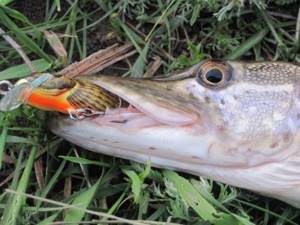
In summer, the water warms up quite well and the pike begins to actively hunt throughout the day, although if it is hot enough in your region, then it is better to go fishing in the morning or evening, since in the heat the predator takes the bait quite reluctantly. From early June to mid-July
Pike is caught very well. During this period, all fishermen recommend using baits with bright, aggressive colors.
At the end of July
The real summer heat begins, during this period the pike leaves shallow water and goes to holes or places with a current, in search of cool water. The fish loses its former aggressiveness and is more attracted to baits with a natural color, which should be carried out quite slowly.
From early to mid August
The toothy one behaves as before, still preferring places with cold water and baits with natural colors.
But in mid-August
the water temperature drops and the pike begins to be active again.
in autumn
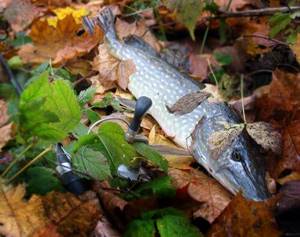
As soon as the water temperature begins to decrease, the pike needs more energy to actively move around the reservoir, which means it needs to eat more. Plus, winter is coming soon, which means you need to gain strength in order to lie down in the pits. It is in the fall that the catches of spinners become the richest.
In September
The water has not yet had time to cool completely, so it is worth trying to look for pike in places with shallow depths.
And in October,
the predator still does not leave its usual parking areas, so meeting it in shallow water is quite normal. During this period, it is better to try to attract pike with large baits. Moreover, it bites equally well on spinners and wobblers of any color.
In November
The pike is still actively feeding, but it is difficult to find it in shallow water, since it goes to the depths along with other fish. Due to such features, in the last month of autumn it is best to catch pike using a jig. You can quite successfully fish with live bait using bottom gear.
Wobblers
Relatively new lures for pike fishing in our country are wobblers. Few anglers use them while continuing to fish with spoons or jigs. Some have tried without success. An even narrower contingent catches successfully, and sometimes more effectively than with conventional bait. Wobblers catch pike not only when it is feeding - and this is their main advantage. With the right wobbler, and with the appropriate play, the toothy fish can be baited to bite, even when the predator ignores other baits.
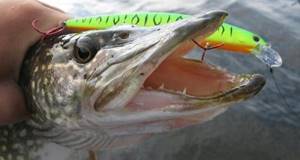
Large minnows for twitching
The right wobblers for pike are, first of all, large twitching minnows. The size of these baits ranges from 110 mm to 160 mm. A simple retrieve of these pike killers, a straight line or a stop and go, sometimes works. However, the main killer weapon of these lures for pike is twitching. With the right twitches, the bait yaws with strong vibrations and rolls, that is, sways, swaying from side to side. Such strong vibrations bring the pike out of its stupor, forcing it to drive the competitor away from the point, and the residual swaying directly causes a bite.
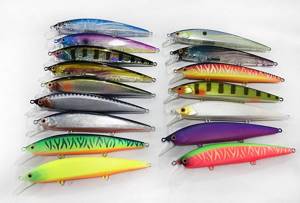
Jakal Rerange
Spinning fishermen who understand 130 wobblers for twitching, it’s not for nothing that they consider them the most catchy lures for pike. Rudra OSP, Jakal Magallon, Megabass Kanata, Daiwa Moretan and a dozen others - these names flash in the Internet space for a reason. However, if you buy such a wobbler, hang it on a spinning rod and pull it like a spoon, most likely there will be no catch. To unlock the potential of these baits, it is important to meet the following conditions.

Jackal Magallon - does not require twitching, works in the surface layer with light twitches
- Choose the right spinning rod. Stubborn wobblers, such as Rudra or 130 orbits, cannot be pulled through with a regular spinning rod with a medium action. These lures are used for pike with light and fast, rigid, elastic rods. The main movement of twitching is a jerk and release of the line so that the bait makes those very residual vibrations.
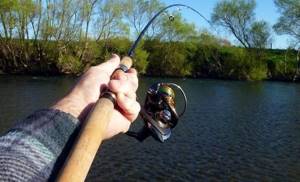
- The spinning rod is equipped with a twisted string, then when casting and twitching, the front hook of the leash will not catch on the leash.
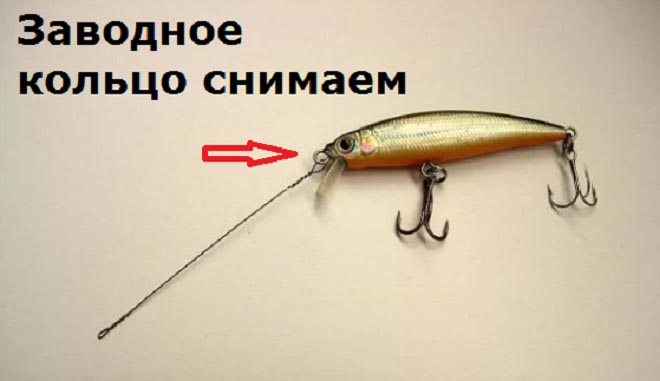
- Each wobbler has an individual approach. This is a point tool. Each bait has a set of specific characteristics. Buoyancy, diving depth, jerk strength to pull through. For beginners, I recommend relying on buoyancy and perseverance when searching for wobblers. On a regular spinning rod you can, for example, race a non-resistant Ito Shiner, but for Rudra or Kanata you will definitely need a Fast or Extra Fast rod with a top weight of 35 grams.
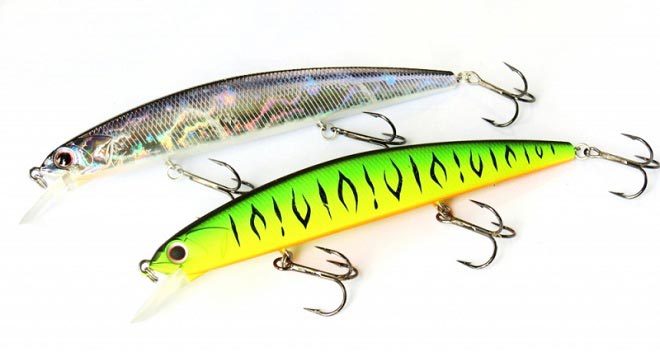
Rudra
Some wobblers for pike attract predators with soft twitching, others with hard twitching. At the same time, one should not forget about uniform or intermittent wiring, pulling with a fishing rod. Before fishing with these baits, you need to study the theory, choose the right fishing rod and choose in your head which specific models of wobblers to look for. Detailed article about pike wobblers:
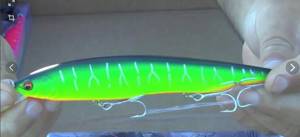
Kanata
Wobblers from aliexpress
Previously, amateur fishermen were confused by the price - original Japanese wobblers cost 1,500-2,000 rubles. However, the monopoly of the Japanese and Americans has been broken. The Chinese produce no less catchy baits at a fraction of the price. The difficulty is that on Aliexpress you can get both a perfectly working wobbler and an absolute slag. When it comes to pike for twitching, the best of the Chinese are definitely replicas from Berking, this can be seen from numerous reviews, videos and personal experience. My personal set of wobblers is almost entirely Berking, because of the price.
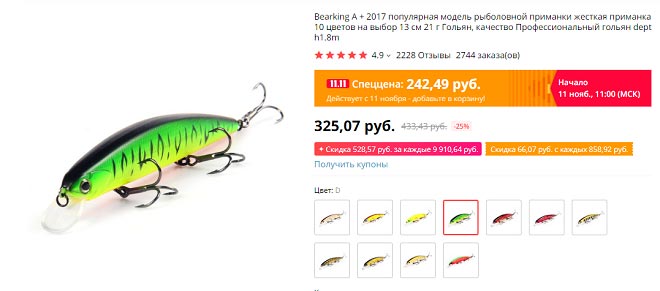
Screen Berking Rudra
Of what Bearking offers, according to reviews, the best are a replica of Rudra, a copy of 160 mm Kanata, Ito Shiner and Magallon. They also have other successful replicas - but it is these four that are killer for pike in the opinion of many spinning anglers. The catchability of these spears has been repeatedly proven in water bodies. The price of these baits is about 300 rubles. I think that buying originals for 2000, given the same catchability of replicas, is pointless. In addition, the hooks and paint on the Berkings are already better than those on the expensive Japanese Megabass.
On Ali you can find even cheaper copies of wobblers, with prices up to 100 rubles. However, in this segment it is easy to stumble upon a bait that doesn’t work. You need to search correctly. How to do this is discussed in detail in the article on finding catchy wobblers from Aliexpress
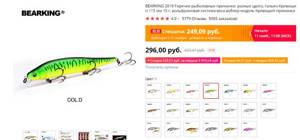
Screen ItoShainer Berking
Shads, large cranks and small minnows
On a regular spinning rod, not specially sharpened for 130 wobblers, you can normally fish with large shad and cranks, as well as non-resistant minnows, which do not require twitching. Wiring – evenly, broaches, pauses, light jerks. In addition to the legendary Jakal Magallon, you can find no less catchy wobblers. These fat guys work on uniform wiring and intermittent twitching, making amplitude oscillations. As an addition to your arsenal, it wouldn’t hurt to have a couple of these wobblers in the box - someday they will save your fishing.

Some spinning anglers seriously bother with such baits and fish mainly with them. Here it is important to follow the general rules of wobblers - compliance of specific baits with the conditions of reservoirs, select them correctly in terms of buoyancy and depth, do the wiring correctly, and for each wobbler it is individual.
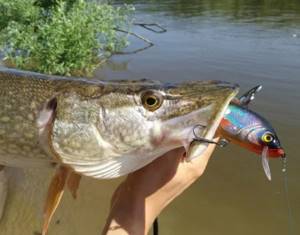
Large shads and fats with a powerful game are good at luring active pike from afar. These baits are good for exploring large water areas during normal biting times. Large perch also do not refuse them. Small cranks and small minnows do not require twitching, but work evenly and jerkily - therefore they are excellent for working on an ultralight.
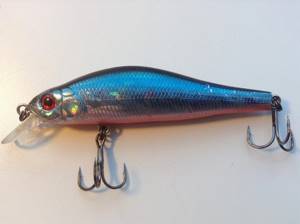
Tsuribito Jerkbait 80f

ZipBaits Khamsin SR
Colors of wobblers for pike
Anglers are constantly arguing about whether pike can distinguish color and which shades of lures are better. It is impossible to say unequivocally what color pike likes. It all depends on the preferences of the predator on a particular body of water, weather and lighting conditions. In one place, the toothy one reacts better to acid, in another – to natural colors. Experienced wobbler breeders recommend taking baits of each model in two colors - acid and natural.
- The most popular color of wobblers for pike in acid is mattiger, black back, green sides with stripes, turning into yellow, orange stripe on the belly. Pike take this color in most places - checked. Another color that showed itself remarkably well in 2018-2019 is fruttiger, or in simple terms, watermelon.
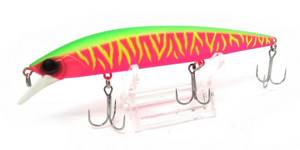
- Among natural baits, it is better to choose wobblers that change color from the back to the belly. Then they are better visible to the pike when oscillating and rolling. Even for a natural silver fish, it is better if the back is dark and the belly is light.
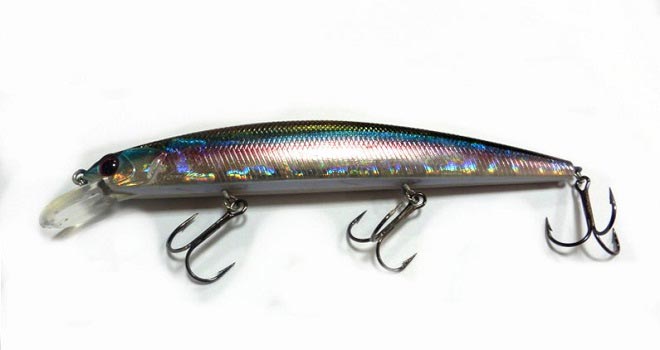
Ratlins (vibes)
Bladeless wobblers with a back attachment are not very well known among the masses, however, some anglers successfully catch pike with them. Ratlins sometimes help out due to vibrating vibrations. Ratlin wiring - tightening and releasing. When jerking, the bait vibrates its back, and when released, it sinks. These baits are convenient for fishing local depressions, lowering the bait exactly to the desired level.

Yu-Zuri Hardcore Drum
Swimbaits
Bladeless compound wobblers wriggle when inserted, attracting pike with movements similar to the movement of a live fish. These are relatively large baits, used more often for catching trophy pike in late summer or autumn. The main wiring is uniform, pulling with pauses.
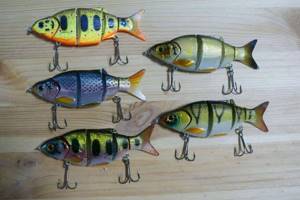
Jerky
A separate direction of spinning is jerking. Heavy and large baits are used. More powerful rods and thick braided cord are also needed. The jerks need to be made even sharper than in twitching - the load on the spinning rod and equipment increases.
- On a jerk spinning rod, special large bladeless wobblers weighing more than 40 grams are used, which usually do not have their own game, but are animated only by the jerk of the rod.
- Gliders are the most common jerks, sliding to the sides during a herringbone jerk. The shape is flat, as if cut from a layer of material.
- Divers - baits with a propeller on the tail, can lure pike evenly with jerks.
- Pullbaits are large jerk baits of great weight, up to 20 cm long and weighing more than 100 grams. Depth is achieved not by a blade, which does not exist, but by heavy weight.
- Twitch baits are jerk baits with a blade, more like ordinary wobblers, only larger.
More about jerk fishing

Salmo slider
Predator feeding and spawning
Any small living creature that finds itself in the predator’s field of vision can become its prey: perch, roach, minnows, ruffs and other fish. On occasion, he does not refuse small bream, silver bream, ide, small pike. More than once, villagers noticed that large predators attacked birds and small animals living in the water. Ducklings, mice, frogs, and muskrats can become targets of attack. There are no restrictions for her - she will happily feast on any living creature that is smaller in size.
To learn more:
Casting net for fishing: poachers' tool
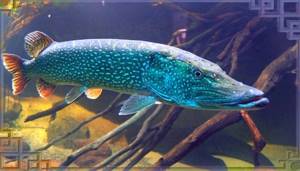
Pike spawning begins soon after the final ice melts, when the water warms up a little. Early spawning is observed in small pikes; large specimens spawn several days or weeks later. Females begin to throw at the age of four, and sometimes three years, males mature a little longer. A shallow place is chosen as a spawning ground - 50-100 cm, where the water warms up faster, which means that the fish will be more active. Here the female lays eggs and the partners fertilize them.
One pike per season can spawn from 20 to 200 thousand eggs - the specific number depends on age and size. Large (up to 3 millimeters in diameter) fertilized eggs have a slightly sticky surface, making them easily stick to objects. But after a few days, the stickiness decreases and they fall to the bottom, where they subsequently grow. The process goes through several stages:
- the egg is not active, develops due to the supply of nutrients;
- The larva hardly moves. It receives everything it needs for life from the yolk sac attached to the stomach;
- The fry swims confidently, feeds on the smallest organisms, gradually turning into an adult.
During spawning, the predator develops a strong hunger, but fishing is not allowed - fishing is poaching and is strictly punishable by law.
Surface lures for pike
In addition to spinners, jigs and wobblers, a set of baits for fishing with a spinning rod for pike requires surface baits - for fishing in shallow waters and in the grass. In summer, the toothy fish likes to stand in thickets where it is impossible to catch with other baits. Such baits are not as demanding on the characteristics of the rod as large wobblers, and they can be fished with ordinary amateur spinning rods with a medium or parabolic action - as long as they are suitable for casting in terms of the test and weight of the bait.
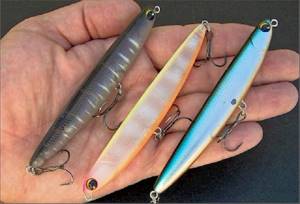
Poppers and walkers
A type of bladeless wobblers specially designed for surface fishing. Wiring is carried out in small jerks. Poppers are baits with a depression in the head, which causes a splash when pulled. For pike in shallow water, splashing and smacking these baits on the surface works well, especially in summer and early autumn.

Walkers, or walkers, sticks are similar in wiring, only there is no recess in the head. When guiding, they also either come to the surface or make yaw movements under it. The walker's wiring takes some getting used to. For beginners, it is better to start with poppers - it is easier to produce a pop with the right jerk. The approach with flowers is the same as with wobblers.

Walker Rapala X-walk
Gliders
This bait is better known among fishermen as the Croatian egg. Due to the design of the body, the only hook is always located at the top, which allows you to carry the bait from above along the surface of the water in overgrown places. This is a common type of pike bait for spinning rods, a non-snagging one that works great in overgrown places in the summer. Through continuous thickets the egg is simply dragged with careful movements of the spinning rod.
Some Croatians are equipped with a recess, like a popper, so when jerking they create splashes or throw out a stream of water. The disadvantage is frequent idle pike bites due to the only hook sticking up, when the predator tries to gently bite the troublemaker from below.
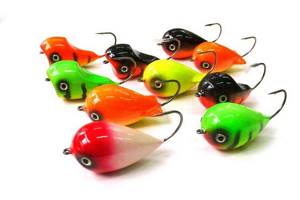
Silicone ducklings, mice and frogs
A recently appeared surface bait for catching pike is an imitation of a frog, duckling, or mouse made of silicone with hooks hidden inside the rubber body. Thanks to this design, the bait passes through reeds and mud well. Due to the design of the hooks, there are also many slippages during sluggish tacking.
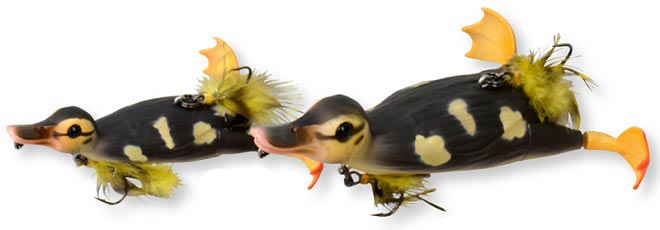
Such decoys quickly fail, as the pike quickly tears them with sharp teeth, and they begin to take on water and sink. However, despite all the shortcomings, frogs for pike are excellent for catching in our reservoirs, and they cost pennies if you take Chinese models from Ali.
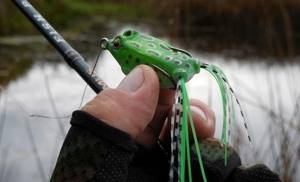
Pike fishing gear
You can catch pike with anything, from primitive old-fashioned baits to professional spinning rods. The choice of gear depends on the personal preferences of the fisherman. Let's look at the most common ones.
Catching pike with summer baits
This gear is suitable for fishing on a pond, lake or small calm river. It is cheap, easy to use and quite effective. Gears with live bait attached to hooks are installed in windows among aquatic vegetation, under tree branches hanging over the water, next to flooded bushes and in other similar places where the object of fishing has the opportunity to successfully hunt fry.
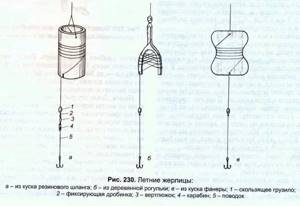
The summer vent is a primitive structure consisting of:
- wooden pole;
- flyers with splits at thin ends;
- strong fishing line wound on a flyer (reserve - at least 7 meters);
- a lead sinker capable of holding live bait (the fish should not drag the rig into the grass);
- a leader (preferably fluorocarbon) connected to the main line using a swivel;
- strong double or single hook.
The installation of the tackle is carried out as follows: the flyer is tied to the pole with a piece of twine, the pole is stuck into the ground at an angle of 45 degrees, the equipment with live bait on the hook is lowered into the water, the required amount of fishing line is released and it is fixed in the split. After that, all that remains is to wait for the bite. The predator that has grabbed the fish will rush to the side, while the fishing line will come out of the split and begin to move away from the flyer. When it ends, self-notching will occur.
Usually, fans of fishing with girders install several of these devices at different promising points, and then check them one by one.
If the target is highly active with such gear, you can count on good results.
Fishing with mugs
The circle is a floating version of the summer girder, consisting of a disc-shaped foam float with an end groove for fishing line and live bait installation. The sides of the disk are painted in different colors, usually white and red. At the moment of a predator attack, the circle turns over with its bright side up, signaling the fisherman about a bite.
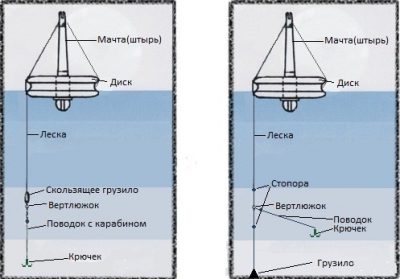
There are two ways to catch pike with mugs. The first (more common) is that gear loaded with live bait is released into free swimming. They slowly drift across the pond and “look” for pike themselves. You won’t be able to fish like this on a fast river, since the gear will be carried away by the current, but on lakes and calm river bays you can use them for very good fishing. The second method involves installing circles at promising points on the anchor; for this they are supplemented with a piece of fishing line and a sinker that can hold the tackle in place. The mugs are placed next to snags and thickets of grass so that live bait cannot reach them.
To fish with circle girders, you will need a boat. To cover as much territory as possible, they are installed or released into free swimming in a checkerboard pattern. Moreover, they all must be in the fisherman’s field of vision, otherwise he will not be able to respond to bites in a timely manner.
Fishing with a rod
A live bait fishing rod is considered to be no less effective a tool for fishing for toothy beasts than for baitfish. From the name of the tackle it is clear that the bait is live bait, and it itself is a more durable analogue of a float rod with long casting. Moreover, not only the rod must be strong, but also all the elements of the equipment, including the hook. The reel can be of any type, either inertia-type or inertia-free, but most fans of pike fishing using this method have come to the conclusion that it is much easier to work with a meat grinder (inertia-free).
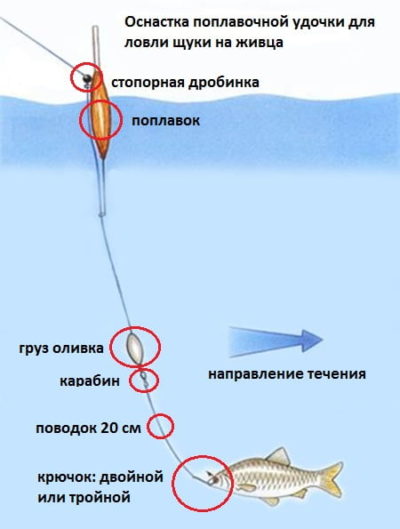
This type of gear uses a special float - clearly visible, with a large carrying capacity. You can buy a large barrel-shaped alarm at a fishing store or make a similar one yourself from a champagne cork. It is clearly visible at a distance of up to 20 meters, and not a single live bait, even the most nimble and strong, can drown it.
A mandatory element of the equipment is a leash. It doesn’t matter what material the leash is made of, Kevlar, titanium, tungsten, or just a piece of guitar string, the main thing is that it can withstand the pressure of pike teeth.
It is good to catch predators with a live bait rod in small bodies of water, for example, on a forest lake or river. In general, it is applicable wherever there is no strong current. You can read about catching pike with winter girders at the link.
Spinnerbaits
Another non-hooking device, but this time intended for underwater wiring, not surface wiring. It is a small rocker, on one wing of which a petal is attached, like on a turntable, and on the other there is a hook with a weight, covered with a bundle of silicone fibers. This type of bait is not very common. When retrieving, the bait is positioned with the weight down and the blade up. Clings to the equipment by the middle ring on the bend. The petal oscillates when playing, attracting the pike, and the toothy one usually grabs the silicone washcloth on the hook.
Anglers who actively use pike spinnerbaits claim that this is a very catchy bait for the toothy predator. It passes underwater thickets and mud well without catching them. And pike loves such places. Both trophy pike and small grass fish take spinnerbaits, and you can make it yourself at home or find it in any fishing store, as well as on Aliexpress.
In addition to Croatian eggs, ducklings and spinnerbaits, there are several more catchy unhooked baits for pike
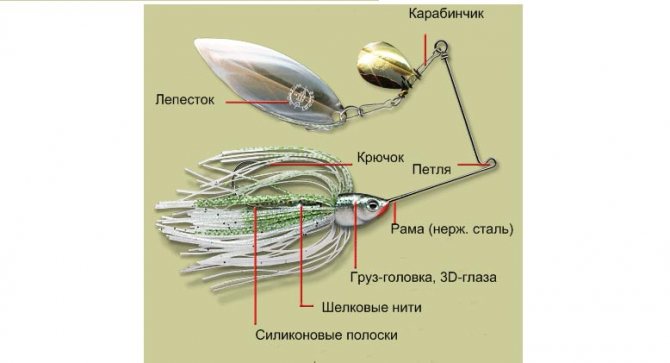
What affects the pike bite
Here is another interesting topic around which many myths and disputes have arisen. Fishing groups often ask the question “When does pike bite in the summer?”, and the answers to it are sometimes funnier than the jokes in “Smehopanorama”.
What do people want to hear, really... That the predator's exit will be at 4:57 am, on a red twister and you need to throw it over your left shoulder? All this is impossible to predict. Sometimes you wait for the “exit” from 5 to 6 in the morning, but it starts at 11. And this happens quite often. There is also such a thing as “predator bite forecast - summer 2018”, here they will tell you exactly when you need to go fishing to catch a trophy.
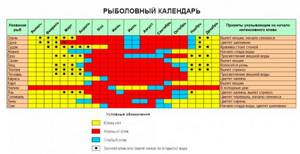
Of course, there are various factors that are determined by the experience of fishermen, but even these cannot be relied upon exactly. These are rather guidelines that you should pay attention to. But at the same time, you need to remember that the pike may not know that it should not bite today due to the incomplete phase of the moon.
Pike streamers
A streamer is a type of large, heavy fly used in fly fishing. In a spinning rod for pike, you need an even larger fly - a whole panicle of wool or fur. It is difficult to find a large pike streamer for spinning on sale - they are used by a narrow group of anglers when searching for trophy pike when the predator refuses to take traditional baits.
These baits work, and on large pike – and that’s a fact. Retrieving is a slow pull, in which the fur or wool flutters sluggishly in the water, depicting a fairly large living creature, which a large pike likes to pick up. This type of bait is difficult to find in the store, but you can make it yourself or to order.
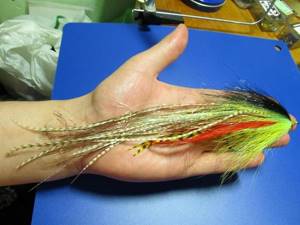
Tackle
For dead fish, as well as for large silicone from 15 cm, you need to use a tackle. For a 20-centimeter vibrotail it is difficult to choose a jig head with a large hook. There are many types of tackle - it can be either an additional suspension for a tee in a jig, or several hooks with a knee joint for attaching a dead fish so that it does not fly off when casting.

Where does pike live?
This is a rather conservative predator. If you have found a successful pool and managed to catch several serious specimens, you can visit here again in a week. In summer she often stands near bridges. The water, running around the supports, creates reverse flow zones - predatory fish love them very much. It is worth paying attention to places where washed-out trees lean low over the water. Insects fall from the leaves, small fish prey on them, and pike feast on the small change. But be careful not to get caught on branches when casting.
To learn more:
Smelt: description of a fish from the smelt family
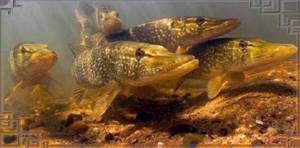
A type of predator, the grass weed, hides in the algae, from where it makes raids on small things floating by, but usually small specimens adhere to this tactic. In September, when the water level in the river decreases, the pike slides into deep pools and lives mainly in them. The number of fish in the bottom depressions may vary - one predator often lives in a small hole, and if it is a full-fledged pool, several trophy specimens may coexist in it. Usually the biggest bait is enough. In November, when fishing on the first ice, it makes sense to choose passages between the reeds - large specimens almost always move along “paved paths”, avoiding swimming into dense vegetation. Knowing where pike are found, you will always return with rich catch.
Seasonal features
In addition to the conditions of the reservoir, the choice of pike bait for a particular fishing trip should be based on seasonal characteristics. In spring, pike prefers small baits (before spawning), since the belly is filled with eggs. In cloudy water it is better to use acidic colors, and in clear water - natural colors. In summer, lures for pike are spoons, wobblers and unhooked baits in overgrown places. We fish in pits with jigs only if we purposefully hunt for the trophy that lives there.
In the spring, pike come to warm areas where reeds sprout and its food supply is maintained - therefore, you will need wobblers with a depth of no more than a meter. In the fall, it goes deeper, begins to feed actively and loves to grab large baits. Therefore, at this time you will need large 130 wobblers with a depth of up to 2 meters or deeper, large silicone, and heavy vibrators.
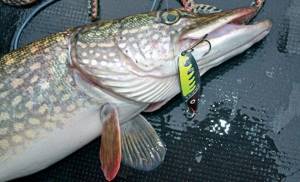
At the beginning of autumn, do not forget about fishing in shallow waters - the pike can stand there, and not on the edge. Therefore, there is no need to put poppers and non-hooks out of the box.
More information about pike lures for autumn
Over time, each angler accumulates his own pool of working pike baits, which are used depending on the season and conditions of the reservoirs in which fishing takes place. You should not look for a universal and always working toothy bait - there are no such things. All of them are designed for specific fishing conditions. The bait should not be considered as an independent element, but only together with the correct tactics, fishing technique and spinning equipment.
Subscribe to the channel:
YouTube channel RYBAFAN
We are VKontakte
Methods of fishing and posting
Over the course of its existence, pike fishing with a spinning rod has changed and taken all possible directions. Among fishermen, only two methods of catching predators using a spinning rod are known and popular:
- trolling;
- casting.
The latter, in turn, is divided into three entertaining and common methods:
- glitter;
- jig;
- twitching.
Trolling
The technique of fishing for pike by trolling is quite simple; any novice fisherman can master it. It consists of the following actions:
- First you need to go by boat to the selected area of the reservoir.
- Now you need to throw the bait in the opposite direction of the boat's movement.
- Then you need to start moving the boat.
- Release some line from the reel and close the clamp.
- While the boat is moving, the bait is constantly in motion.
- As soon as you notice a bite, hook and get the fish.
Often, for trolling, wobblers are chosen as bait, much less often they are caught using oscillating spinners of impressive size.
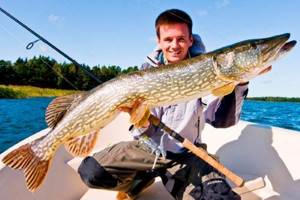
This is a very interesting way of fishing, which allows fishermen to easily accomplish two main tasks of a spinning rod:
- determine the location of the fish;
- catch a big pike.
It is best to go trolling fishing from mid-summer (when the spawning ban has already ended) until the end of autumn. Very often, after catching fish, the boat is anchored and the place is fished using the usual method for everyone, using a spoon or wobbler.
Spoon fishing
Fishing for pike using spinning rods and lures begins in mid-summer and continues until late autumn, when the reservoirs begin to be covered with ice. The technique for placing oscillating and rotating spinners is identical. But the wiring of the turntable should be more stable (meaning fewer pauses and sharp jerks).
There are 4 main types of spinner fishing when fishing with a spinning rod:
- Winding the fishing line onto the reel at a constant speed - uniform wiring
. - Winding fishing line onto a reel with an interruption of 3-4 seconds - stepped wiring
. - Following the pause, there is a sharp jerk with the tip of the spinning rod - a jerk retrieve.
- Giving the tip of the rod additional play during a stepped or uniform retrieve - twitching
.
Twitching
Twitching is the name given to catching pike with a spinning rod using lures, often wobblers, which do not have their own game. Artificial lures create very beautiful movements when twitching the tip of the rod, which makes the pike bite on them.
Jig
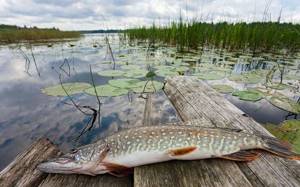
Surely, many anglers have heard about jig fishing for pike. This is a fairly common fishing method that uses silicone baits. Silicone baits are attached to jig heads or eared sinkers.
But jig fishing includes several different types, which differ in the type of installation and wiring of the bait:
- Classic stepped wiring
. Installation of the bait, rigidly attached with a sinker, to the end of the main fishing line. - Drop shot rig
. A weight is mounted at the end of the main line, and the bait itself is located a little higher; it is tied without a leash. An excellent feature of this equipment is the ability to actively play with the bait in one place. - Installation on a branch lead
(Moscow equipment). Spaced gear, which is known among many fishermen, features the separation of cargo and bait. A sinker is fixed at the end of the fishing line, and a leash is tied just above it (20-50 centimeters), and the equipment is already mounted to it. - Texas rig
. A sliding sinker in the shape of an olive or bullet moves freely along the main line, and the bait is tied to the end of it. - Carolina rig
. It has some similarities with the previous one, but the sinker is on a spaced leash, and not on the main line.
A feature of the last three equipment is the possibility of fishing in hard-to-reach areas of the reservoir, in which, for example, catching pike in the summer with a spinning rod from the shore using wobblers or spoons would be impossible or quite difficult. This gives them an advantage over other gear.

